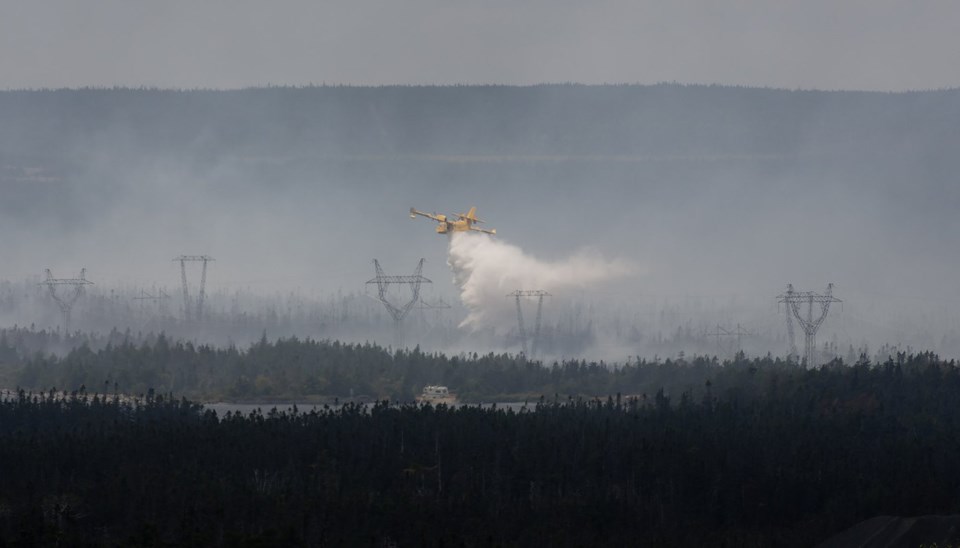ST. JOHN'S — There was a very happy chicken in a suburb of St. John's, N.L., on Friday after residents who had been forced to leave their homes because of a wildfire were finally cleared to return.
Hazel, a four-year-old red sex-link chicken, belongs to Susan Barrett, who was evacuated from her Paradise, N.L., home on Tuesday. Barrett was staying at her parents with her husband and their two German shepherds; Hazel had to spend her days sequestered in a garage.
On Friday afternoon, barely an hour after officials announced an end to the evacuation order, the family was home and Hazel was once again running free. "Oh my God, she's the happiest. She's out in the yard, on the outskirts of the woods there, and she's living her best life," Barrett said in an interview.
"I'm a little bit leery, though, because we're still under an (evacuation) alert," Barrett added. "I'm thinking, if they let us go back home, they must be pretty confident that we won't have to leave again. But we're leaving all our valuables and things still packed in our little camper."
The wildfire that prompted the evacuation broke out Monday, near Paddy's Pond, about 15 kilometres south of downtown St. John's. It was still burning Friday, measuring about three square kilometres, and roughly 20,000 people remained on evacuation alert, including Barrett and her husband. The alert requires residents to be prepared to leave their homes at a moment's notice.
Four out-of-control fires were burning across the province Friday, the largest of which did not bring residents good news that day. Officials announced on Friday morning that the fire near Kingston, N.L., had spread along the northwest shore of Conception Bay and destroyed a 60-student elementary school in Western Bay.
"The devastating loss of Cabot Academy is felt beyond the walls of the school, it is a loss for students, staff, families, and the entire region," said a statement from the province's teachers association.
"We will work closely with Government of Newfoundland and Labrador on a back-to-school plan for September and together, we will get through this."
The churning Kingston wildfire had grown to encompass more than 91 square kilometres as of Friday morning. The fire has forced about 3,000 people from their homes and destroyed an estimated 100 houses and structures along the Bay de Verde Peninsula, which is home to centuries-old fishing communities spread along rugged, rolling cliffs.
A building dating back about 115 years that was once a Methodist school hall was also lost, local officials said in a Facebook post. It was a registered provincial heritage structure.
Premier John Hogan said authorities have begun contacting people whose homes have been destroyed. "Our thoughts are with you all," Hogan said. "And of course, those individuals are still awaiting word. We continue to think about you as well."
Eighty firefighters with the Canadian Armed Forces and 20 from Ontario were battling the flames alongside counterparts from Newfoundland and Labrador, he said. Six water bombers and a heavy-lift helicopter were expected to start dousing the flames from above on Friday, once prohibitive cloud conditions cleared up.
In central Newfoundland, officials announced a highway that had been closed by another fire would reopen on Saturday for limited travel. A fire south of Grand Falls-Windsor had shut down Bay d’Espoir Highway, which is the only route connecting the southern Connaigre Peninsula with the rest of the province. A press release said government staff would escort traffic in one direction at a time through the section of the road near the fire.
In Nova Scotia, fire officials worried more wildfires will ignite in the days ahead after thunderstorms rolled across the province Thursday night and into Friday morning. Forest protection director Jim Rudderham said lightning can penetrate deep into the ground, which means it can take some time for the resulting heat and fire to emerge.
Eleven wildfires were burning across mainland Nova Scotia on Friday, including an out-of-control fire in Annapolis County that forced the evacuation of about 100 people.
Provincial officials asked for help from water bombers in another province, but the aircraft could not make it to Nova Scotia because of the long line of thunderstorms, Rudderham said. The availability of water bombers has been stretched thin because of the ongoing wildfires across Atlantic Canada.
In New Brunswick on Friday, there were 23 active wildfires, including six that were out of control. The province said 40 firefighters from Alberta were scheduled to arrive in New Brunswick on Saturday, and that 20 from Nova Scotia were leaving "to support wildfire efforts in their region."
This report by The Canadian Press was first published Aug. 15, 2025.
Sarah Smellie, The Canadian Press



